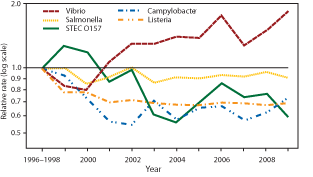
† The position of each line indicates the relative change in the incidence of that pathogen compared with 1996 to 1998. The absolute incidences of these infections cannot be determined from this graph. Data from 2009 are preliminary.
However, the incidence rate of Salmonella has remained about the same over the 10-year period, and the rate of Vibrio infections-typically caused by eating raw shellfish-shot up 85% compared with the first three years of CDC surveillance. Vibrio infections, however, represent a small portion of the overall total of foodborne illnesses.
The only significant decline in incidence in recent years other than for E. coli O157 was for Shigella infections. Although some Shigella infections are transmitted by food, most are probably transmitted directly from one person to another, often among children in child care settings, rather than through food, says the study.
FoodNet conducts active surveillance for nine pathogens commonly transmitted through food, and it leads studies designed to help health officials understand how foodborne diseases are affecting Americans. The nine diseases include infections caused by Campylobacter, Listeria, Salmonella, STEC O157, Shigella, Vibrio, Yersinia, Cryptosporidium and Cyclospora. While the 2009 rates of most of the nine illnesses that are tracked through FoodNet sustained declines since FoodNet began in 1996, most have shown little change since 2004.
“The interventions begun in the late 1990s were successful in decreasing some of these foodborne diseases, but we haven’t seen much recent progress,” said Chris Braden, MD, acting director of CDC’s Division of Foodborne, Waterborne, and Environmental Diseases. “To make additional strides against these diseases and ultimately better protect the American people from foodborne illness, CDC, our federal and state partners, and the food industry will need to try new strategies.”
To optimally prevent foodborne illness, the routes of exposure to these pathogens must be better understood so additional targeted control measures can be developed. While known associations between illness and undercooked foods have been studied, recent outbreak investigations have identified novel food and non-food vehicles, including jalapeno peppers, peanut butter-containing products, raw cookie dough and direct contact with baby chicks, turtles and African dwarf frogs.
Following the 1993 outbreak of E. coli O157:H7, the federal government declared O157 an adulterant. It then implemented HACCP production systems, established FoodNet and PulseNet and set a goal of cutting O157 illness in half by 2010. PulseNet is run by the CDC and brings together public, state and local health and food regulatory agency laboratories in the